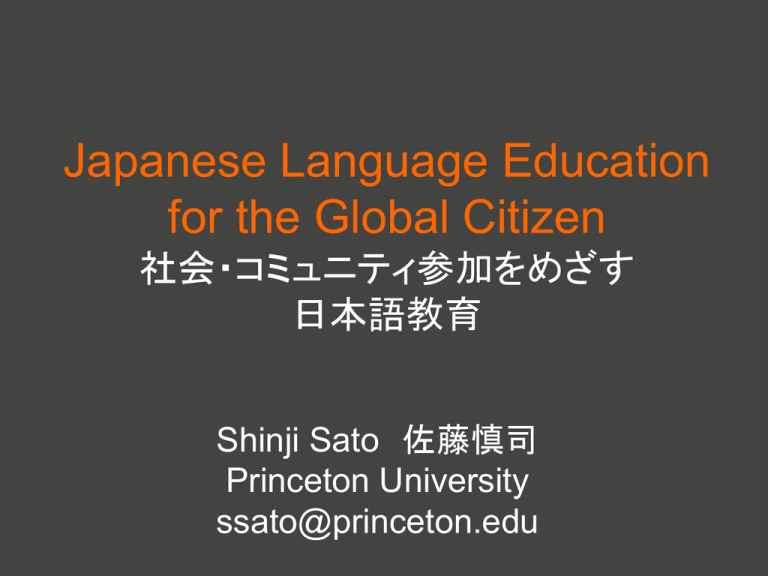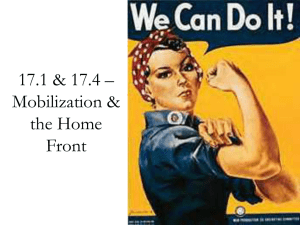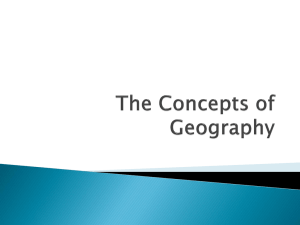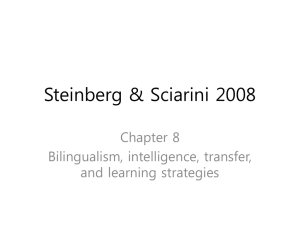Procedure
advertisement

Japanese Language Education for the Global Citizen 社会・コミュニティ参加をめざす 日本語教育 Shinji Sato 佐藤慎司 Princeton University ssato@princeton.edu Questions 問題提起 Japanese language education (JLE) does not exist in isolation. • JLE has been influenced by the sociocultural and historical milieu. Japanese language education tends to precede the related fields, the university, and communities. • Can JLE influence the sociocultural and historical milieu in which it is located? This Talk 1. Japanese Language Class and Sociocultural Milieu – History of Japanese Studies and Japanese Language Education in the U.S. – University’s Mission in the Global Era – Paradigm Shift in the Foreign Language Education 2. Language Education for the Global Citizen – Projects 3. Conclusions History of Japanese Studies and Japanese Language Education in the U.S. (Steinhoff 2013) アメリカにおける日本研究と日本語教育の歴史 1. 1950-60s: Language and Area Studies – the U.S. Military Intelligence Services founded its own specialized language school 2. 1970s- 80s: Economic Competition – the rise of the Japanese economy 3. 1990-Current: Cultural Studies • the top three reasons students study Japanese (Japan Foundation 2011). • interests in Japanese language • communication • to gain knowledge on manga and anime Mission Statements in the Global Era グローバル時代における大学の使命 • Princeton in the Nation’s Service and in the Service of All Nations (Princeton University) • Leverage our environment to connect students, staff, alumni, industry and the community to create sustained opportunities for collaborative learning, innovative research and enduring relationships. (University of Technology, Sydney) • Community engagement: Be a valued partner with key communities (University of South New Wales) Paradigm Shift in the Foreign Language Education 外国語教育研究におけるパラダイムシフト Views on Language Learning 1. Psychometric Approach – Treat language and culture rather as a static and uniform entity. • master the language structure accurately before using the language in a “real” situation 2. Sociocultural Approach – Knowledge on language & culture, the actual use of language, and a learner’s identity are all influencing each other. – Treat language and culture as a dynamic, diverse, fluid, and organic entity. • Leaning by using language How to Set Goals for Japanese Language Program 日本語プログラムの目的・目標設定 What Teachers & JLP Program Want to Teach Learners’ Needs Demands of Departments, Schools, & Societies Language Education for the Global Citizen 社会・コミュニティ参加をめざすことばの教育 このせいかつ ざんねんさんにん • http://www.youtube.com/watch?v=7Fa_M8SxLVI Language Education for the Global Citizen 社会参加をめざすことばの教育 (Sato & Kumagai 2011) The Goals of Language Education – To teach/learn the ‘standard’ form of a language (and culture); – To become able to act on/participate in the communities (社会・コミュニティ) as a member using language • What are Communities? – Communities are fluid and multi-layered. – People can belong to, shift within, or create multiple communities. • What is Language? – A language vs. Metrolingualism (Otsuji & Pennycook 2010) – Multimodal Aspects (e.g., tone, facial expressions, body movement; use of visual info., sounds, space, etc.) What is meant by “act on/participate in the community”? 「社会・コミュニティ参加をする」とは? 1. Learn rules and norms (e.g., customs, values, behavior patterns) of the communities 2. Examine the rules and norms critically 批判的に分析する 規則を学ぶ Act on/Participate in the community 3. Make an effort to maintain or transform the rules if necessary through negotiating with others in the community 受け継ぐ、変革する 4. Take responsibility as a member of the communities メンバーとしての責任を担う 5 Key Principles for Language Education for the Global Citizen 5つのキーポイント (Sato & Kumagai 2011) 2. Individual Interest 興味 1. SelfActualization/ Personal Goal 自己実現 Language Education for Global Citizens 3. Content 内容 5. Diversity 4. Context 多様性 文脈 1. Supporting Students’ SelfActualization/Personal Goals 自己実現 • Redefine Learning as a means to achieve a personal goal (i.e., self-actualization) • Create opportunities in curriculum for learners to think about questions such as: – ‘What do I want to do with this language?’ – ‘What kind of a language user I want to become?’ – ‘Why and with whom do I want to communicate using this language?’ • Set own short-term and long-term learning objectives 2. Nurturing Students’ Individual Interests 興味 • Provide an opportunity for learners to explore and further their own interests • Position learners as agents of their own learning (学習者主体) • Nurture students’ individual, diverse interests →‘Project-based’ language learning (e.g. Beckett & Miller 2006) 3. Integrating Content and Language Learning 内容 • Overcome the schism between lower level ‘language-focused’ curriculum and upper level ‘content-focused’ courses • Reconsider the dichotomy between ‘language’ and ‘content’ • Integrate ‘content’ into language learning from the beginning stage of language learning → Content-based language learning (e.g., Brinton, Snow, & Wesche 1989) 4. Emphasizing the Context of Language Use 文脈 • Experience/understand different contexts call for different language uses (e.g., styles; use of ひらがな, カタカナ, 漢字; choice of vocabulary, etc.) • Become aware of the multimodal aspects (e.g., tone, facial expressions, body movement; use of visual info., sounds, space, etc.) in both oral and written communication • Learn to use the “appropriate” multimodality in order to best communicate own messages/intensions 5. Understanding Diversity 多様性 • Recognize and respect the “diversity” that exists in any group/community • Problematize static, stereotypical, monolithic, and essentialized representations of language, culture, and society Language Education for the Global Citizen 社会参加をめざすことばの教育 (Sato & Kumagai 2011) Steps: 観察 分析 1. 2. Observe the language use in real life settings Analyze the language use and content critically 意見交換 多様性認識 規範と比較 関わる 3. Exchange opinions with various people 4. Recognize that different kinds of interpretations exist 5. Compare norm and actual use; Realize that norms are often arbitrary 6. Relate to communities creatively using the language Language Education for the Global Citizen 社会参加をめざすことばの教育 (Sato & Kumagai 2011) Projects • Beginning Level • TV/UStream Project • Katakana/Orthography Project • Advanced Level • Global Issue Project • Thinking about My Future and Japanese Language Learning Project Video Project Princeton University Introduction • http://www.youtube.com/watch?v=r6s5Xjxckqo Katakana/Orthography Project カタカナ日本の文字プロジェクト (Sato & Kumagai 2011) Objectives • Explore various uses of Katakana. • Observe how Japanese textbooks explain katakana and think about why those textbooks explain katakana in such manners. • Produce literary works using various Katakana expressions. Katakana/Orthography Project 23 5 Key Principles for Language Education for the Global Citizen 5つのキーポイント (Sato & Kumagai 2011) 2. Individual Interest 興味 1. SelfActualization/ Personal Goal 自己実現 Language Education for Global Citizens 3. Content 内容 5. Diversity 4. Context 多様性 文脈 Language Education for the Global Citizen 社会参加をめざすことばの教育 (Sato & Kumagai 2011) Steps: 観察 分析 1. 2. Observe the language use in real life settings Analyze the language use and content critically 意見交換 多様性認識 規範と比較 関わる 3. Exchange opinions with various people 4. Recognize that different kinds of interpretations exist 5. Compare norm and actual use; Realize that norms are often arbitrary 6. Relate to communities creatively using the language Global Issue Project 社会に関わろうプロジェクト (Sato & Hanabusa 2011, Nishimata, Kumagai, & Sato, in writing) Objectives By using Japanese, get involved in social and global issues • Gather information by reading, listening, or watching, • State and exchange opinions • Interact (関わる) with the (actual) world and society actively as well as critically Global Issue Project (Sato & Hanabusa 2011, Nishimata, Kumagai, & Sato, in writing) Procedure 1. Choose a social issues that interests you and create a vocabulary list 2. Submit the outline and revise the outline based on the comments made by: • Class instructor (individual meeting) • TAs (native speakers of Japanese) • Classmates Project Outline (Questions originally in Japanese) 1. What is a social or global issue that interests you? 2. What is the relationship between the issue and you? Why are you interested in it? Why is it important for you? 3. What messages would you like to convey? What is the significance of your conveying this message in Japanese? 4. In order to convey your message, which media do you think would be effective? Why is the media you choose suitable? 5. What do you think should be done in order to solve the social or global issue you chose? What are some of the actions you could take by using Japanese? Global Issue Project (Sato & Hanabusa 2011, Nishimata, Kumagai, & Sato, in writing) Procedure 1. Choose a social issues that interests you and create a vocabulary list 2. Submit the outline and revise the outline based on the comments made by: • Class instructor (individual meeting) • TAs (native speakers of Japanese) • Classmates 3. Create final evaluation criteria Global Issue Project (Sato & Hanabusa 2011, Nishimata, Kumagai, & Sato, in writing) Evaluation Criteria for the Final Project 1 2 3 4 5 6 Language: Grammar, chinese character etc. Design: Photos, design etc. Content: Theme, structure, flow, interesting, easy to read, new information etc. Awareness of the audience: Consideration for the audience, what are the merits to the readers? Originality and creativity Acceptance of comments from others Global Issue Project (Sato & Hanabusa 2011, Nishimata, Kumagai, & Sato, in writing) Procedure 4. Submit a draft of the project two or more times (2 individual meetings) 5. Present the final project on the blog 6. Think about what you should do to make the target audience read/watch your project and execute the action 7. Read the blogs and exchange comments and opinions on the blog 8. Take actions to solve the problem 9. Final evaluation Blog Comments by a Partner School Student 大学・院生のヤマダと申します。パピーミルのことは、 こちらのブログ記事で初めて知りました。 ペットショップの小さな檻にいれられた子犬や子猫を目 にするとき、「かわいい」という気持ちだけでなく、 「かわいそう」と感じることがありました。 「この子たちは、どこから来るのだろう」と疑問に思う 人も少なくないのか最近は、犬やネコの種類、値段と 一緒にブリーダーの名前や顔写真を檻の前に表示して いるところもあるようです。 ペットを取り巻く状況について直視することは勇気がい るようにも思いますが、「かわいい」「かわいそう」 等という一時的な感情だけでなく、まずは「知るこ と」ですねー。 その上で、責任をもって判断することが大事だなと思い ました。 ありがとうございました。勉強になりました。 Amy’s Response ヤマダさんへ、 初めまして!エイミーと申します! 私のブログを読んでくれてありがとうございます。 私も子犬と子猫を目にする時子たちはかわいそう な生物だと思います。ブリーダーの名前や顔写真 を檻の前に表示しているところはアメリカにはぜ んぜん見たことがありませんでした。それはつば らしいアイディアだと思います。でも、ペットシ ョップへ行く時いつもブリーダーについてよく本 当のことを言いません。 Global Issue Project Ocean Pollution • http://www.youtube.com/watch?v=uIhPpYAOi7g 5 Key Principles for Language Education for the Global Citizen 5つのキーポイント (Sato & Kumagai 2011) 2. Individual Interest 興味 1. SelfActualization/ Personal Goal 自己実現 Language Education for Global Citizens 3. Content 内容 5. Diversity 4. Context 多様性 文脈 Language Education for the Global Citizen 社会参加をめざすことばの教育 (Sato & Kumagai 2011) Steps: 観察 分析 1. 2. Observe the language use in real life settings Analyze the language use and content critically 意見交換 多様性認識 規範と比較 関わる 3. Exchange opinions with various people 4. Recognize that different kinds of interpretations exist 5. Compare norm and actual use; Realize that norms are often arbitrary 6. Relate to communities creatively using the language Thinking about My Future and Japanese Language Learning Project 見つめ直そう自分の将来と日本語プロジェクト (Sato & Shibata 2014) Objective • Think about – what aspect(s) of Japanese language proficiency you would like to improve (and how) – your future goal, and – your contributions to the community that you (would like to) belong. • Integrate the above three while doing the project. Thinking about My Future and Japanese Language Learning Project Procedure 1. Set goals for the following three criteria: 1. Japanese language proficiency, 2. your future, and 3. your contributions to the community that you (would like to) belong. 2. Find, engage in, and contribute to a community by making the most of your own background. 3. Have peer group discussions and individual consultations with the instructor to discuss the development of your project. Thinking about My Future and Japanese Language Learning Project Topics 1. Language Exchange – Japanese vs. English – Japanese vs. Korean 2. Opinion Exchange – – – – East Asian Politics Animal Protection Japanese (Traditional) Music Nuclear Power Plants 3. Community Involvement – Children’s Book Reading Club Assessment 1. 2. 3. 4. Can Do Statement Individual Consultation with the Instructor Mid Report Final Report & Speech Thinking about My Future and Japanese Language Learning Project Case Study 1: Eva Chu • Sophomore & Electrical Engineering Major • Taiwanese American from California • Diligent, Shy • She would like to share the enjoyment of (Japanese) language learning with others. Thinking about My Future and Japanese Language Learning Project Thinking about My Future and Japanese Language Learning Project 1. Read the children’s book that she wrote when she was a high school student 2. Create a children’s book with local high school students and read at the children’s book reading club Thinking about My Future and Japanese Language Learning Project 1. Read the children’s book that she wrote when she was a high school student 2. Create a children’s book with local high school students and read at the children’s book reading club 3. Read internet articles about science and technology 4. Integrate 1-3: Read the book, “くさる(Rotten)” at the children’s book reading club. 科学や工学 『くさる』 なかのひろたか Thinking about My Future and Japanese Language Learning Project Can Do Statement (Original in Japanese) (Full Score: 3) 1. Content (1) I can create a children’s book with other students of Japanese. 3 (2) I can talk about why I am studying Japanese. 3 (3) I can cooperate with others to realize the plan that I created. 3 2. Contribution to the Community (1) I can read children’s book to children at the book reading club. 3 (2) I can show the children’s book and share the enjoyment of Japanese and Japan. 2 (3) I can answer questions from high school students about college Japanese learning. 3 3. Japanese Proficiency (1) I can speak Japanese more naturally than before. 2 (2) I can explain about my project in Japanese. 3 (3) I can write polite email messages in Japanese. 3 コミュニティからのコメント お話会への影響 • メンバーの意識が内側から外側に向ける事が容易 になりました。チューさんの活動のお陰で、○○高 校の学生さんも巻き込んで!の○○のコミュニティ ーに根付いた活動をより積極的に考えられる様にな りました。○○図書館からも、多くの外国語おはなし 会の中でも日本語が重要な位置づけとして認めて 頂き、具体的には図書館の日本語本を充実するた め、金銭的援助も優先的にして頂ける様になりまし た。 コミュニティからのコメント お話会メンバーへの影響 • 『読む、話す』と『伝える』事の違いと難しさを、改め て感じました。チューさんの自作絵本の言葉の手直 しをお手伝いさせて頂きましたが、作った話をおは なし会に来て下さるお子さん達の年齢層に合わせ た物に書き直す事や、意味やストーリーの流れをわ かり易くするための言葉選びが大変難しく、私の勉 強にもなりました。また読むときの抑揚についても『 何を伝えたいか』をはっきりさせる事で、必要なエネ ルギーをコントロールしながら使う。その為には言葉 だけでなく、日本語特有の『行間を読む』経験も読み 手として大切だとも、改めて感じました。 コミュニティからのコメント 子どもたちへの影響 • 若い方の参加はそれ自体が、もう子供達に良い影 響を与えていると思います。チューさんの自作自画 のオリジナル絵本は、ストーリーを考え、それを字や 絵に表現するのは難しい作業ですので、子供達に 夢や可能性を与えて下さったと思います。お話の後 に自作絵本からの『ぬりえ』を用意して下さったり、 絵を書いたりと、最後のフォローまでしっかり考えて 下さって、『読み手からの一方通行』では無く、『共に 分ち合う作業』までして下さった事は大変嬉しく感じ ました。 お陰さまで、子供達は皆チューさんの事を 今も覚えてくれています。 5 Key Principles for Language Education for the Global Citizen 5つのキーポイント (Sato & Kumagai 2011) 2. Individual Interest 興味 1. SelfActualization/ Personal Goal 自己実現 Language Education for Global Citizens 3. Content 内容 5. Diversity 4. Context 多様性 文脈 Language Education for the Global Citizen 社会参加をめざすことばの教育 (Sato & Kumagai 2011) Steps: 観察 分析 1. 2. Observe the language use in real life settings Analyze the language use and content critically 意見交換 多様性認識 規範と比較 関わる 3. Exchange opinions with various people 4. Recognize that different kinds of interpretations exist 5. Compare norm and actual use; Realize that norms are often arbitrary 6. Relate to communities creatively using the language 5. Understanding Diversity 多様性 • Recognize and respect the diversity that exists in any group/community • Problematize static, stereotypical, monolithic, and essentialized representations of language, culture, and society Politics of diversity (difference & the sameness) Is recognizing and respecting diversity enough? We sometimes need to accomplish something together using language Conclusions 結論 Japanese language education (JLE) does not exist in isolation. • JLE has been influenced by the sociocultural and historical milieu. Japanese language education tends to precede the related fields, the university, and communities. • JLE can influence the sociocultural and historical milieu in which it is located. How to Set Goals for Japanese Language Program 日本語プログラムの目的・目標設定 What Teachers & JLP Program Want to Teach Learners’ Needs Demands of Departments, Schools, & Societies Conclusions 結論 A new vision such as the Japanese language education for the global citizen can only be realized by closer and frequent dialogue and collaboration between the Japanese language program, Japanese studies and related academic fields, the university, the surrounding communities and the global community. dialogue 対話 collaboration 協働 Selfactualization 自己実現 Princeton Japanese Pedagogy Forum (PJPF) プリンストン日本語教育フォーラム • May 9-10, 2015 (tentative) • Check the PJPF website: 謝辞 • 社会・コミュニティ参加をめざす日本語教育 – 熊谷由理 • ユーストリーム生中継プロジェクト – 纐纈憲子 • 社会に関わろうプロジェクト – 熊谷由理、纐纈憲子、西俣美由紀 • 見つめ直そう自分の将来と日本語プロジェクト – 柴田智子 References 佐藤・ドーア(2008) 『文化、ことば、教育』 明石書店 佐藤・熊谷(2010)『アセスメントと日本語教育』 くろしお出版 佐藤・熊谷(2011)『社会参加をめざす日本語教育』 ひつじ書房 佐藤・熊谷(2013)『異文化コミュニケーションを問う』 ココ出版 佐藤・高見・神吉・熊谷(校正中)『内容重視の批判的日本語教育(仮題)』 コ コ出版 西俣・熊谷・佐藤(執筆中)『社会参加をめざす日本語教育:実践編(仮題)』コ コ出版 Sato, S. & Doerr, N (2014). Rethinking Language and Culture in Japanese Education. Clevendon: Multilingual Matters. Konoeda, K., Kumagai, Y., Nishimata, M. & Sato, S. (forthcoming) Fostering Multimodal Literacy and Critical Multiliteracies: Japanese language learners’ podcasting project. Multiliteracies in World Language Education. London: Routledge. Sato, S (2009). Communication as Intersubjective Activity: When Native/NonNative Speaker's Identity Appears in Computer-Mediated Communication. In Native Speaker Concept: Ethnographic Investigations of Native Speaker Effects. Edited by Neriko Doerr. New York: Mouton de Gruyter. • いつでも気軽にお声をおかけください! • ご意見、感想、コメントなどもお待ちしておりま す。 ssato@princeton.edu • 研究、教育実践のネットワークを広げるため にFacebookもしています!









